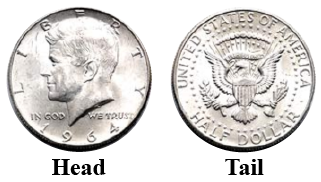Calculating Probability

How to calculate Probability?
\(Probability = \frac{No.\,of\,ways\,an\,event\,can\,happen}{Total\,number\,of\,outcomes}\)
In our case, lets calculate the probability of flipping a coin and throwing a head.
Total number of outcomes are 2 - {Head, Tail}. No. of ways, our event can occur - 1 - {Head}.
So the probability is - \(\frac{1}{2} = 0.5\)
Can probability be more than 1 or less than 0?
No. Probability always lies between 0 and 1.
When is the probability 0?
When the event cannot occur. Eg- Probability of throwing a 7 on a dice.
When is the probability 1?
When the event certain to occur. Eg- Probability of throwing a number between 1 and 6 on a dice.
More examples
What is the probability of throwing an even number on dice?
Total number of outcomes are 6 - {1,2,3,4,5,6}.
No. of ways, our event can occur - 3 - {2,4,6}.
So the probability is - \(\frac{3}{6} = 0.5\)
What is the probability of throwing an factors of 6 on dice?
Total number of outcomes are 6 - {1,2,3,4,5,6}.
No. of ways, our event can occur - 4 - {1,2,3,6}.
So the probability is - \(\frac{4}{6} = 0.667\)
What is a Sample Space?
A sample space is a collection or a set of possible outcomes of a random experiment. In the above example of throwing a dice, the sample space is - {1,2,3,4,5,6} which are all the possible outcomes of the event.


